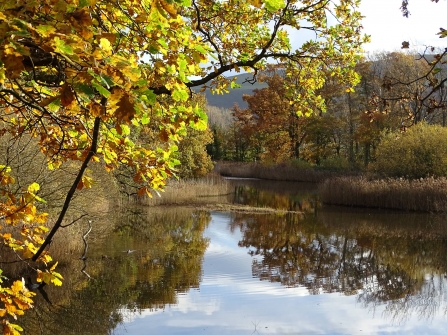This beautiful, pocket-sized nature reserve is situated on the edge of the Penrhyn Castle Estate, overlooking the Menai Strait. It comprises woodland and grassy glades surrounding three lagoons. Crucially, the lagoons vary in salinity because, whilst the reserve is fed by freshwater from the hills, it is also topped up with salt water from the estuary side. This gradation in brackishness makes for an interesting change in habitats throughout the system – supporting freshwater invertebrates at the ‘top’ and crabs and eels at the ‘bottom’.
Never a dull moment …
Heron with an eel at Spinnies Aberogwen Nature Reserve © Steve Ransome

Spinnies Aberogwen Nature Reserve © Bethan Vaughan Davies
Spinnies Aberogwen is perhaps most notable for its birds and viewing hides. A few hours of exploring the three hides on site should let you see a range of common and less common garden birds on feeders; mallard, little egret, moorhen and water rail dabbling and skulking in the lagoons and reeds; and mute swan, curlew, oystercatcher and grey heron on the estuary. There are also the semi-resident and iconic kingfishers – perhaps the most photographed birds (ospreys apart) in North Wales!
The third of the hides – built thanks to a wonderful donation by one of the volunteer wardens, Steve – was officially opened by Iolo Williams on 21 June. The work was undertaken by Fred Kehoe of Kehoe Countryside – one of the Wildlife Trust’s Natural Partners and generous long-term supporters. The resultant building is a true labour of love. All locally sourced framework is made from Douglas Fir and the cladding from oak materials, with all the timber having been felled and dried by Fred. The whole structure sits on recycled plastic legs to ensure its longevity in the wet conditions.







